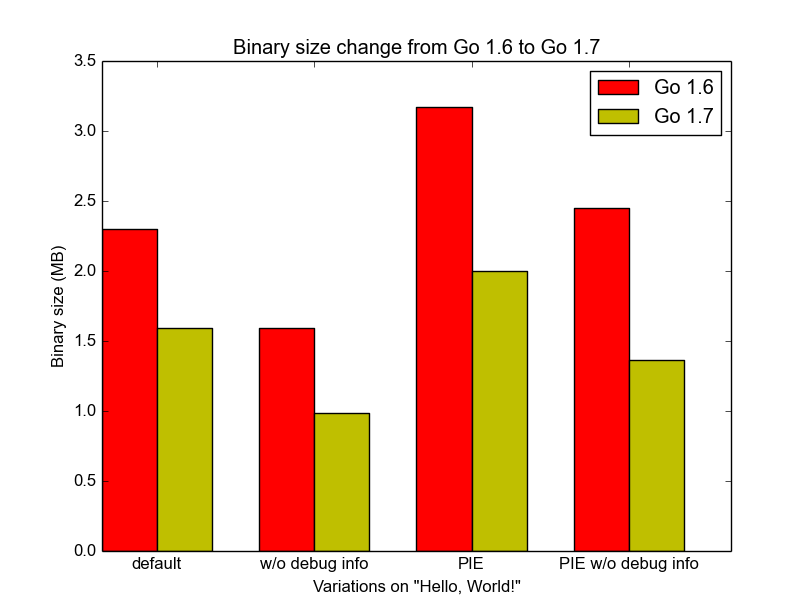Go 博客
Smaller Go 1.7 binaries
2016/08/18
Introduction
Go was designed for writing servers. That is how it is most widely used today, and as a result a lot of work on the runtime and compiler is focused on issues that matter to servers: latency, ease of deployment, precise garbage collection, fast startup time, performance.
As Go gets used for a wider variety of programs, there are new issues that must be considered. One of these is binary size. It has been on the radar for a long time (issue #6853 was filed over two years ago), but the growing interest in using Go for deploying binaries on smaller devices — such as the Raspberry Pi or mobile devices — means it received some attention for the Go 1.7 release.
Work done in Go 1.7
Three significant changes in Go 1.7 affect binary size.
The first is the new SSA backend that was enabled for AMD64 in this release. While the primary motivation for SSA was improved performance, the better generated code is also smaller. The SSA backend shrinks Go binaries by ~5%. We expect larger gains for the more RISC-like architectures like ARM and MIPS when those backends have been converted to SSA in Go 1.8.
The second change is method pruning. Until 1.6, all methods on all used types were kept, even if some of the methods were never called. This is because they might be called through an interface, or called dynamically using the reflect package. Now the compiler discards any unexported methods that do not match an interface. Similarly the linker can discard other exported methods, those that are only accessible through reflection, if the corresponding reflection features are not used anywhere in the program. That change shrinks binaries by 5–20%.
The third change is a more compact format for run-time type information used by the reflect package. The encoding format was originally designed to make the decoder in the runtime and reflect packages as simple as possible. By making this code a bit harder to read we can compress the format without affecting the run-time performance of Go programs. The new format shrinks Go binaries by a further 5–15%. Libraries built for Android and archives built for iOS shrink further as the new format contains fewer pointers, each of which requires dynamic relocations in position independent code.
In addition, there were many small improvements such as improved interface data layout, better static data layout, and simplified dependencies. For example, the HTTP client no longer links in the entire HTTP server. The full list of changes can be found in issue #6853.
Results
Typical programs, ranging from tiny toys to large production programs, are about 30% smaller when built with Go 1.7.
The canonical hello world program goes from 2.3MB to 1.6MB:
package main
import "fmt"
func main() {
fmt.Println("Hello, World!")
}When compiled without debugging information the statically linked binary is now under a megabyte.

A large production program used for testing this cycle, jujud, went from 94MB
to 67MB.
Position-independent binaries are 50% smaller.
In a position-independent executable (PIE), a pointer in a read-only data section requires a dynamic relocation. Because the new format for type information replaces pointers by section offsets, it saves 28 bytes per pointer.
Position-independent executables with debugging information removed are particularly important to mobile developers, as this is the kind of program shipped to phones. Big downloads make for a poor user experience, so the reduction here is good news.
Future Work
Several changes to the run-time type information were too late for the Go 1.7 freeze, but will hopefully make it into 1.8, further shrinking programs, especially position-independent ones.
These changes are all conservative, reducing binary size without increasing build time, startup time, overall execution time, or memory usage. We could take more radical steps to reduce binary size: the upx tool for compressing executables shrinks binaries by another 50% at the cost of increased startup time and potentially increased memory use. For extremely small systems (the kind that might live on a keychain) we could build a version of Go without reflection, though it is unclear whether such a restricted language would be sufficiently useful. For some algorithms in the runtime we could use slower but more compact implementions when every kilobyte counts. All of these call for more research in later development cycles.
To the many contributors who helped make Go 1.7 binaries smaller, thank you!